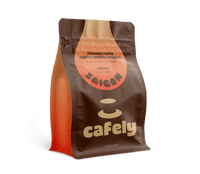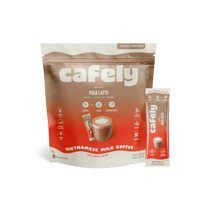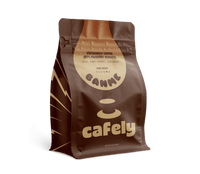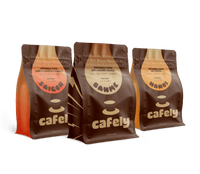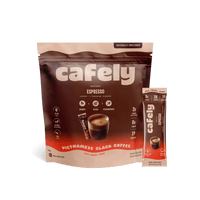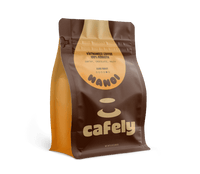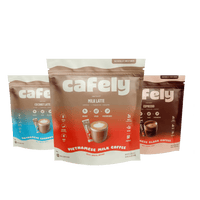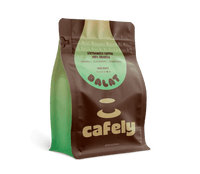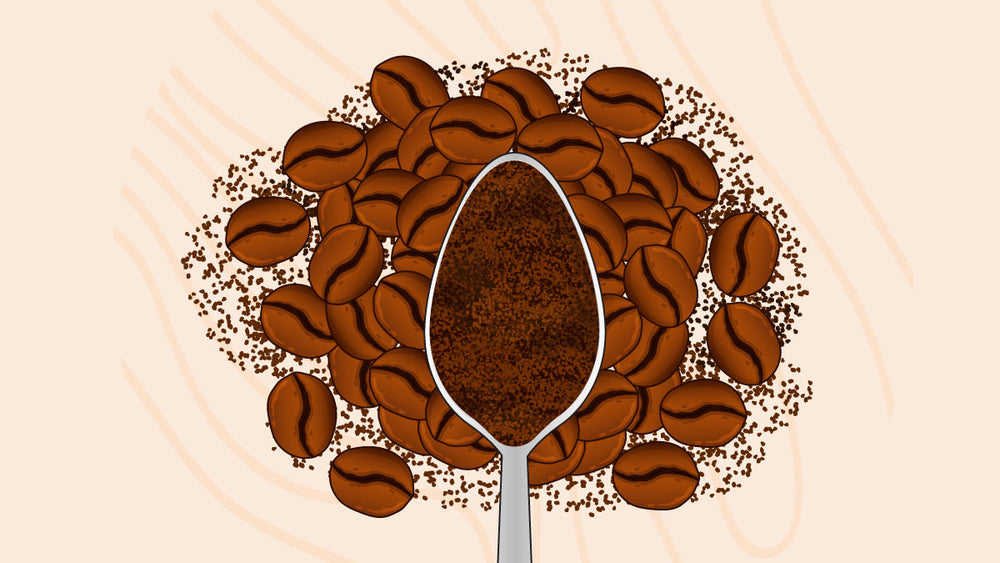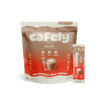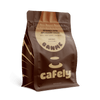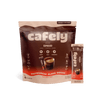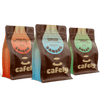If you want to brew the perfect cup of coffee, the first step should be to find high-quality whole-bean coffee. However, this adds an additional step to your morning coffee routine — grinding the beans.
Creating the correct grind size consistently is just as important as the quality of your coffee beans. There is no “one size fits all” grind for coffee — different brewing methods require different grinds.
In this article, you'll learn how to find the perfect grind size for your preferred brewing method and which coffee grinders can help you achieve this…
Coffee Grind Size Chart
Use the coffee grind size chart below to learn which type of coffee, grind, and coffee-to-water ratio to use during brewing.
|
Brewing Method |
Grind Size |
Coffee-to-Water Ratio |
Coffee Recommendation |
|
Drip Coffee Maker |
Medium to medium-fine |
1:16 |
|
|
Pour-Over |
Medium-fine to medium-coarse |
1:15 to 1:17 |
|
|
Phin Filter |
Fine to medium-fine |
1:8 to 1:10 |
Saigon OG, Hanoi Cofee |
|
French Press |
Coarse |
1:12 to 1:15 |
|
|
Espresso Machine |
Fine |
1:2 |
DaLat |
|
Moka Pot |
Fine to medium-fine |
1:8 |
|
|
Aeropress |
Fine to medium-fine |
1:15 to 1:17 |
DaLat, Saigon OG |
|
Turkish Cezve |
Extra fine |
1:10 |
DaLat |
|
Cold Brew (French Press) |
Coarse to medium coarse |
1:4 |
|
|
Coffee Bags |
Medium to medium-coarse |
N/A (1 bag to 1 cup water) |
DaLat, Saigon OG, Hanoi, BanMe Coffee |
Grind Size Consistency Guide

If you're new to grinding coffee, it can be difficult to understand the differences between coarse, medium-coarse, fine, and extra fine. How do you know when you've produced the right consistency?
Use the guide below to help you understand what the different grind levels mean in terms of texture:
- Coarse Grind: Resembles sea salt or kosher salt — large, distinct grounds.
- Medium-Coarse Grind: Similar to rough sand or demerara sugar — slightly finer than a coarse grind.
- Medium Grind: Similar texture to regular sand or granulated white sugar — consistent and slightly powdery.
- Medium-Fine Grind: Slightly finer than granulated sugar — smooth and powdery but still granulated.
- Fine Grind: Similar to refined table salt or flour — soft and powdery but not clumpy.
- Extra-Fine Grind: Feels like powdered sugar or talcum powder between the fingers — silky and prone to clumping.
Guide: How Fine to Grind Coffee (10 Brewing Methods)
Different brewing methods require different grind levels.
Find your favorite method below and learn which grind size is best and tips on brewing the perfect cup…
1. Drip Coffee
Drip coffee is made using a drip coffee maker. This brewing method produces a dark, thin coffee by slowly pouring hot water over ground coffee through a paper cone filter. The brew is collected in a carafe below.
You need a medium to medium-fine grind for drip coffee. We recommend an arabica coffee such as Cafely DaLat or an arabica and robusta blend such as Saigon OG blend for drip coffee.
Brewing tips: Wet your paper coffee filter before brewing and use fresh, filtered water for the perfect drip coffee.
2. Pour-Over Coffee
Pour-over coffee is similar to drip coffee. However, it’s made using a “manual” brewer. Pour-over coffee is made by pouring freshly boiled water over ground coffee. It passes through a cone filter and into a collection chamber or coffee mug below.
You need a medium-fine to medium-coarse grind for pour-over coffee, depending on the type of brewer you own. For brewing coffee using a Chemex, opt for medium-coarse. For brewing coffee with a Hario V60, opt for a medium-fine grind. If you're looking for the best coffee options for a Chemex brewer and Hario, go with beans that offer bright acidity and complex flavors — light to medium roast 100% arabica beans are ideal.
We recommend 100% arabica, such as our DaLat coffee, for pour-over.
Brewing tips: Bloom the coffee by adding a small amount of hot water before adding the rest. Blooming allows for a more even extraction, resulting in a better cup of coffee.
3. Phin Filter (Vietnamese Coffee)

The phin filter is a traditional Vietnamese brewing device. It consists of four parts — a filter plate, brewing chamber, gravity press, and lid. Coffee is added to the filter plate, and hot water is poured over the top. The gravity press goes on top, and the brew gradually drips through the filter into a cup below.
You need a fine to medium-fine grind for the phin filter. We recommend a 100% robusta coffee for making Vietnamese coffee with a phin filter. Our HaNoi robusta coffee is specifically designed for the phin.
Brewing tips: Take time to bloom the coffee before brewing. Be patient — it can take some time until the first drips pass through the filter plate and up to 10 minutes for the brew to finish.
4. French Press Coffee
The French press is a simple immersion coffee brewer. Ground coffee is added to the container before hot water is poured over the top. The plunger is then placed on top, and the coffee is left to steep for four to seven minutes before plunging to strain.
You need a coarse grind for the French press — the coarseness of the coffee is important as it prevents too much sediment from reaching the final cup. We recommend a 100% arabica coffee such as Cafely DaLat or a light blend such as Saigon OG for the French press.
Brewing tips: Avoid leaving the brew in the French press with the coffee grounds once it has finished brewing. Doing so can lead to over-extraction. Pour up the coffee immediately once brewing is complete.
5. Espresso Coffee
Espresso coffee is made using an espresso machine. Ground coffee is added and tamped into a portafilter before it’s attached to the group head on the machine. Then, the machine is set to brew for 25–30 seconds to produce a rich, dark shot with a creamy, velvety crema.
Use a fine grind for espresso coffee. We recommend a 100% arabica coffee such as DaLat for making espresso.
Brewing tips: Tamp the grounds gently and make sure to stop brewing after 30 seconds to avoid over-extraction. Make sure to use fresh, filtered water and high-quality arabica for the perfect espresso.
6. Moka Pot Coffee
The moka pot produces a strong espresso-like brew. It’s a stove-top brewer that works by passing pressurized boiling water up through a filter basket filled with ground coffee. The concentrated brew is collected in a chamber above.
Use a fine to medium-fine grind for moka pot coffee. We recommend an arabica coffee such as Cafely Dalat for the moka pot — this will create a bold, smooth, naturally sweet brew similar to an espresso.
Brewing tips: Make sure to monitor the temperature of your stove closely when brewing to avoid burning the coffee. Avoid over-packing the coffee into the filter basket — this can lead to uneven extraction.
7. Aeropress Coffee
The Aeropress brew combines immersion brewing with pressure-driven extraction. It produces strong, concentrated coffee that’s almost a blend between French press and espresso coffee.
Coffee is brewed with the Aeropress by adding a filter to the chamber, filling it with coffee, adding hot water, and pressing the plunger down over a cup.
Use a fine to medium-fine grind size for the Aeropress. We recommend an arabica coffee such as DaLat or a smooth blend such as Cafely Saigon OG for the Aeropress.
Brewing tips: The Aeropress doesn’t offer great heat retention so preheat the brewer with freshly-boiled water before adding coffee.
8. Turkish Coffee
Turkish coffee is a rich, strong brew that's boiled rather than brewed. It's made by adding ground coffee to a traditional brewing pot called a cezve. The pot is then taken on and off the heat several times until a strong, rich brew is created.
You need an extra fine grind size for Turkish coffee. The coffee must be ground extra fine so the grounds settle to the bottom of the cup after serving. Arabica coffee is best for Turkish coffee. We recommend DaLat coffee.
Brewing tips: Take care when scooping the foam from the top of the cezve during brewing — this is an essential part of Turkish coffee. Add it back to the brew once served for a traditional cup of Turkish coffee.
9. Cold Brew Coffee
Cold brew coffee is made through immersion. It’s usually made in a French press by combining ground coffee and cold water. The combination is refrigerated overnight and the brew is strained and enjoyed the following day.
Use a coarse to medium-coarse grind when making a cold brew with a French press. 100% arabica is the best coffee for cold brew. Its sweet, smooth flavors create a pleasant, low-acidity brew.
Brewing tips: Cold brew takes a long time. Make sure to leave the coffee in the water to extract for at least 18 hours. The longer you leave it, the stronger the cold brew will be.
10. Steeping (Coffee Bags)
Coffee bags are used for steeping coffee grounds in water without the need for brewing equipment. These brewing bags can be filled with coffee and used similarly to a tea bag.
Use a medium to medium-coarse grind size when making coffee bags. You can brew any type of coffee by steeping. We recommend BanMe (100% Peaberry Robusta) for a strong, dark cup of coffee.
Brewing tips: Make sure to steep the coffee bag for long enough before straining — this brewing method can take some time.
What Coffee Grinder Should You Use? Burr vs. Blade Grinders
There are two main types of coffee grinders — the burr grinder and the blade grinder. Both grinders achieve the same thing. However, one is better in terms of consistency.
If you’re brewing coffee using a drip coffee maker, pour-over setup, or French press, the type of coffee grinder you use isn’t particularly important. Both burr and blade grinders can produce the coarse grind needed for these simple brewing methods.
If you're brewing espresso, moka pot coffee, or Turkish coffee, a burr grinder is essential if you want to create a consistent fine or extra fine grind size. Blade grinders will finely grind coffee, but the grounds are often inconsistent in size.
If you care about brewing great coffee using a multitude of brewing methods, the burr grinder is the best option.
FAQs: How Fine Should You Grind Your Coffee?

Want to learn more about coffee, grind size, and brewing?
Head over to the Cafely Blog and read the answers to the frequently asked questions below for more insight…
1. How Long Does Ground Coffee Stay Fresh?
Once coffee is ground, more of its surface area is exposed to the air. Oils quickly dissipate and the flavor fades with every passing day. When freshly ground coffee is stored in an airtight container and kept cool away from sunlight, you can expect it to stay fresh for one to two weeks.
2. What’s the Difference Between Arabica and Robusta Coffee?
Arabica and robusta are coffee beans from two different coffee species. Arabica beans is known for its smooth, sweet, mild flavor. The beans contain 1–1.5% caffeine. Robusta coffee is known for its bold, bitter, woody flavor. The beans contain 2–2.7% caffeine — twice as strong as arabica.
3. How Does Grind Size Affect Coffee Flavor?
Finer grounds have a larger surface area exposed to the water, which leads to faster extraction. Coarser grounds have less surface area, resulting in a slower extraction. Brewing finely ground coffee often results in a stronger, more intense brew than brewing coarse ground coffee.
4. What is a Burr Coffee Grinder?
A burr grinder is a type of coffee grinder that uses two abrasive surfaces (burrs) that revolve around each other. They crush the coffee beans into a uniform size. They produce a consistent grind size and are capable of producing extremely fine grounds.
5. What is a Blade Coffee Grinder?
A blade grinder is a type of coffee grinder that uses a rotating blade to grind coffee coffee beans. They are simple in design and work similarly to a food blender. They’re capable of grinding coffee to a fine consistency but the grind size can be inconsistent.
6. Why Is A Consistent Grind Important When Brewing Coffee?
A consistent grind is important when brewing coffee because it directly impacts the extraction process. Coffee grounds with a consistent size are exposed to the same area of water, leading to a consistent extraction of flavors and oils.
7. What Grind Size Works Best For Espresso?
A fine grind size — similar in texture to sand or table salt — is best for making espresso. Its fine grind size allows for a quick extraction of flavors, oils, and solubles.
8. What’s The Difference Between Flat And Conical Burrs?
Flat burrs in a coffee grinder compose of two parallel abrasive plates. These plates sit horizontally, and the coffee beans are ground between them. Conical burrs consist of two parts — a rotating cone-shaped burr that fits inside a stationary ring-shaped burr. The beans are ground as they fall through the burrs.
9. How Often Should You Clean Your Coffee Grinder?
Cleaning your coffee grinder regularly is essential if you want to maintain its performance. If you use your grinder daily, it’s a good idea to clean it after each use by wiping the grinding chamber and emptying the hopper. Deep cleaning by disassembling and brushing out or running cleaning pellets through the grinder should be done once every few months (depending on the frequency of use).
10. Can You Grind Coffee Too Fine?
Yes. You can grind coffee too fine for your brewing method. For example, using finely ground coffee in a French press will result in a thick, over-extracted brew with a powdery mouthfeel.
